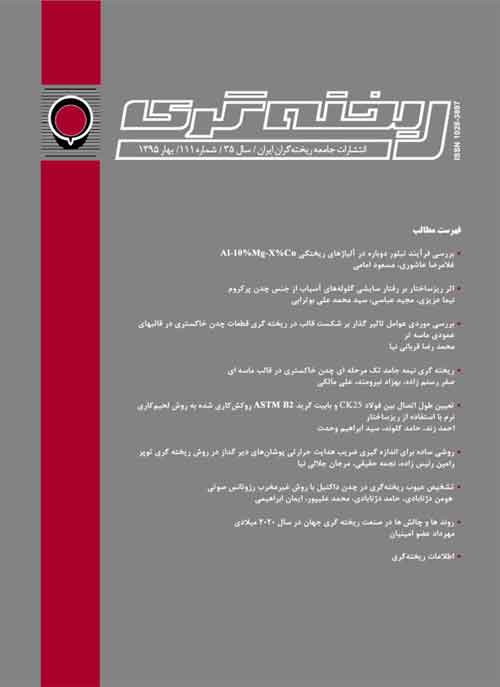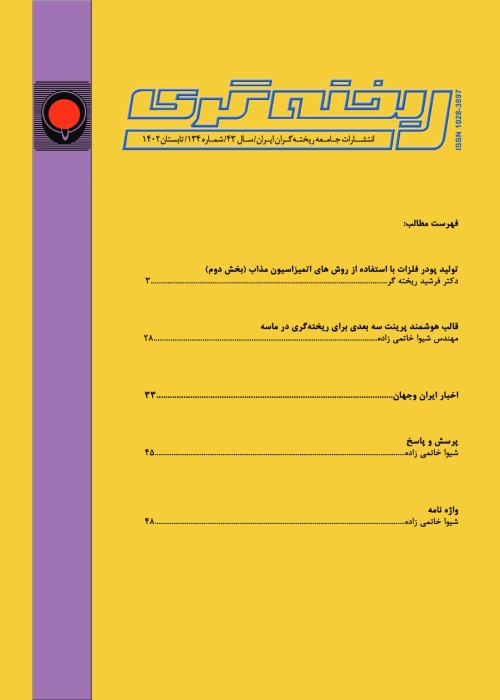فهرست مطالب

نشریه ریخته گری
پیاپی 111 (بهار 1395)
- تاریخ انتشار: 1395/03/30
- تعداد عناوین: 9
-
-
بررسی فرآیند تبلور دوباره در آلیاژهای ریختگی Al-10%Mg-X%Cuصفحه 2
-
اثر ریزساختار بر رفتار سایشی گلوله های آسیاب از جنس چدن پرکرومصفحه 11
-
بررسی موردی عوامل تاثیر گذار بر شکست قالب در ریخته گری قطعات چدن خاکستری در قالب های عمودی ماسه ترصفحه 19
-
ریخته گری نیمه جامد تک مرحله ای چدن خاکستری در قالب ماسه ایصفحه 26
-
تعیین طول اتصال بین فولاد CK25 و بابیت گرید ASTM B2 روکش کاری شده به روش لحیم کاری نرم با استفاده از ریزساختارصفحه 32
-
روشی ساده برای اندازه گیری ضریب هدایت حرارتی پوشانه ای دیر گداز در روش ریخته گری توپرصفحه 38
-
تشخیص عیوب ریخته گری در چدن داکتیل با روش غیرمخرب رزونانس صوتیصفحه 43
-
روند ها و چالش ها در صنعت ریخته گری جهان در سال 2020 میلادیصفحه 51
-
اطلاعات ریخته گریصفحه 55
-
Investigation of recrystallization process in Al-10%Mg-X%Cu casting alloyPage 2The utilization of Al-Mg alloys at low temperatures or low humidity atmosphere is a systematic approach to use of these alloys. Since Al-Mg alloys are susceptible to diffusion of magnesium to grain boundaries and formation of a continuous network of intermetallic in the grain boundaries. Thus, thought to be the addition of alloying elements is the most effective way to improve the mechanical properties of these alloys. One of the main elements in the aluminum alloys is copper; because of its high solubility in aluminum it causing the precipitation hardening properties. Magnesium and copper in aluminum created various phases such as θ, S and T. So finding the relationship between of process, microstructure and other properties of quantitative and qualitative perspective is very important. Therefore, in current research, the effect of copper and the artificial aging process was investigated on microstructural properties of Al-10% Mg alloy.Keywords: Al-Mg alloys, microstructure properties, Cu
-
Effect of Microstructure on the Wear Behavior of High Cr Cast Iron Grinding BallsPage 11Effects of microstructure on the wear resistance of high chromium cast iron grinding balls were investigated. For this porpoise, 40mm diameter cast balls were selected and austenitized in the temperature of 900, 950 and 1000°C, for 100 and 180 min and then all samples were tempered in 200°C for 120min. The microstructural studies and phase analysis were carried out with SEM, optical microscope equipped with image analysis and XRD. In addition, hardness measuring was conducted by vickers method and also wear behaviors were examined using a pin on disk instrument and abrasive wheel. The results showed that as cast microstructure had austenitic dendrites and eutectic cells. After heat treatment cycles, more austenite converted to martensite and secondary carbides precipitate in matrix that its transformations are more related to austenitzing temperatures. It is recognized that maximum hardness can be achieved in 950°C, but optimum wear resistance can be obtained in 900°C that has lower retained austenite and has low carbon martensite.Keywords: Grinding Ball, High chromium cast iron, Retained austenite, Wear
-
The Case Study of Affecting Factors on Broke Mold in Grey Iron Casting Parts by Green Sand Vertical MoldsPage 19This research is a case study to relationship with mold broke for grey casting parts in green sand molds. Three sample of the casting parts were damaged by broke mold that material were grey cast iron with A type graphite and inoculated with Sr-bearing inclusion at the vertical green sand line (DISA) in the mold with a dimension (350 × 770 × 600 mm3), those were investigated. At first identified all factors that were influencing on broke mold. The factor investigated for each sample as separately. The factors that effective to this study on broke mold are include water content percent, permeability, the amount of Bentonite and Coal dust consumed in blend of sand molding, pouring temperature, embedded vent in suitable location of the gating system and squeeze value exerted on the mold that effectives each one were evaluated.Keywords: Broke mold, Water content, Permeability, Bentonite, Coal dust, Vent
-
Single Stage Semi-Solid Casting of Gray Cast Iron in a Sand MoldPage 26Most popular semi-solid casting processes involve two stages. The first stage includes producing a semi-solid slurry which is formed in a high strength metallic die in the second stage of the process. Because of high pressures applied on the semi-solid slurry during the second stage, the die should be made of expensive alloy steels. In the present research, the possibility of single stage semi-solid casting of a high melting point alloys, i.e. a hypereutectic gray cast iron, in a sand mold was investigated. For this purpose, a specially designed runner chilled sand mold rigged to a vertical centrifugal casting machine was used. The hypereutectic gray cast iron was poured in the sand mold at 1275 and 1285 ºC and at rotation speed of 400 rpm. The microstructures and hardness of the specimens were then characterized. The results showed that the average length of the eutectic flake graphite and the thickness of the Kish graphite in semi-solid centrifuged castings were smaller and their hardness was higher than those in the castings prepared by conventional gravity or centrifugal casting methods.Keywords: Semi-Solid Casting, HypereutecticGray Cast Iron, Centrifugal Casting, Sand Mold
-
Determining of the diffusion depth of Babbitt ASTM B2 on CK25 steel coated by soft soldering process by using microstructurePage 32The purpose of this research is determining the bond length of steel-Babbitt thrust bearing that is manufactured by Babbitt casting by using microstructure study. In this research in order to achieving an acceptable bond, first the preform cleaned with a chemical process. Then the Babbitt ASTM B2 (Grade 2) poured on steel CK25 preform with casting process. Microstructure study has been done by using FESEM2 at magnification of 30000. Results showed that the diffusion depth of Babbitt to steel is 6.6μm.So, the bond length is 6.6μm.Keywords: Dissimilar Bond, Babbitt, SEM, Thrust Bearing, Axial Bearing
-
A Simple Method for Determination of the Thermal Conductivity of refractory coating in LFC processPage 38In full mold casting process, mass transfer of liquid and gaseous pyrolysis materials out of the mold cavity and also the refractory coating have considerable effects on heat transfer solidification rate. These phenomena cannot be ignored in solidification simulation soft wares. In this paper a simple method for estimating the thermal coefficient of refractory coating is described. It is based on recording the output of two thermocouples, one inside the molten metal and the second in the sand mold. A 2D FDM simulation program models the solidification of a melt, which is surrounded by a constant flux boundary condition. In each time step, the constant heat flux changes so that the simulated temperature is close to the experimental measured one. After obtaining the variation of output heat flux from the melt, the overall heat transfer coefficient and also the thermal coefficient of coating material can be calculated.Keywords: mold casting process-heat transfer-FDM
-
Detection of Casting Defects in Ductile Cast Iron Using Acoustic Resonant InspectionPage 43Acoustic Resonant Inspection is a nondestructive testing technique based on modal analysis (vibration response) of parts. In this method, structural dynamic features of parts such as natural frequencies and damping factors are analyzed. These features are directly correlated with mechanical properties (Elastic Modulus) and dimensions. A structural defect changes the mechanical properties and hence reduces some of the natural frequencies and increases the damping factors. By analyzing and comparing the parameters of Good and Defective parts, we can detect defective parts. In this study, Peugeot knuckle arms were analyzed: 500 good samples selected from different production lots during 2 months, 50 samples with low nodularity 70% to 85%, 50 samples with very low nodularity 30% to 60%, and 56 samples with other casting defects such as cold shut, shrinkage cavity, mismatch mold and dimensional deviations. All samples were tested with ultrasonic method, and 10% of the parts were metallographically examined. Acoustic Resonant Inspection of the parts were performed by EddySonic-AR system. During the training phase, 200 good samples were introduced as reference parts to the system, and 17 vibrational modes were analyzed. The modes were also verified with theoretical FEM method calculated in ANSYS program. The effect of process variations, especially in mass and dimensions, were compensated by mathematically modelling of unwanted variations. Then different criteria based on single or multivariate formulation were defined to sort Good and Defective parts. This technique could detect and separate 100% of defective parts.Keywords: Acoustic Resonant Testing, Casting Defects, Ductile Cast Iron
-
Trends and Challenges in Foundry Industry 2020Page 51
-
Casting InformationPage 55


